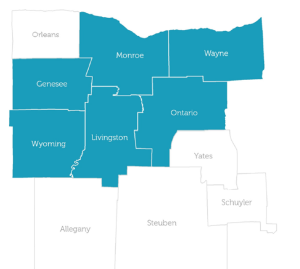United Way affiliates across New York, Texas, Maine and Indiana have merged or plan to merge in the coming months. In all, 14 affiliates will merge to become six affiliates, with the largest consolidation occurring in the Rochester, N.Y. region.
Six affiliates will form United Way of Greater Rochester and the Finger Lakes, covering six counties: Genesee, Livingston, Monroe, Ontario, Wayne, and Wyoming, encompassing more than 5,000 square miles, 50,000 donors.
“This has been in discussion for years. We’ve been loosely working together for decades with Rochester providing back-end support, making sure efficient operations as far as HR and IT,” President and CEO Jaime Saunders told the Rochester Business Journal. Greater Rochester’s Synergy Fund helps local nonprofits explore affiliation as a and initiate possible mergers to increase operational efficiencies and improve program services. There are 23 active Synergy projects, she said.
 United Way of Greater Rochester reported revenue of $47.5 million for the fiscal year that ended March 2020, including $30 million in contributions and grants, and $115 million in net assets. Eight employees among the five other affiliates will join Greater Rochester for a total of 98 employees.
United Way of Greater Rochester reported revenue of $47.5 million for the fiscal year that ended March 2020, including $30 million in contributions and grants, and $115 million in net assets. Eight employees among the five other affiliates will join Greater Rochester for a total of 98 employees.
Saunders will serve as the merged organization’s president and chief executive officer, with Cicely Strickland-Ruiz as chief operating officer, Jennifer Cathy as chief impact officer, Barbara Pierce as chief development officer, and Laurie Ganon as chief financial officer. Former regional directors will continue to serve in leadership roles: Kari Buch as associate director of community impact, and Tammy Hathaway and Carol Pettis as senior regional development managers.
The combined United Way has created a new Regional Advisory Council and Regional Cabinets to advise and inform strategies and ensure local communities from across the region are represented in the new organization. In addition, its Board of Directors has added members from the previous United Ways’ leadership, who will work alongside those who already live and work across county boundaries.
July 1 marked the mergers of at least two other pairs of United Way affiliates. United Way of Greater Portland and United Way of York County got together to form United Way of Southern Maine. It culminates discussions between the two affiliates that began in late 2020.
United Way of Greater Portland President & CEO Liz Cotter Schlax will serve as president/CEO of the new entity while Brian Petrovek, president and CEO of United Way of York County, will return to the hockey industry with the Colorado Eagles, a minor league hockey team in Loveland, Colo.
Muncie, Ind.-based Heart of Indiana United Way, created July 1, is a conglomeration of United Way of Delaware, Henry and Randolph Counties and United Way of Madison County.
Since July, officials at several other affiliates have announced the intention to merge operations. United Way of Northwest Indiana will serve Lake, Porter, Jasper, Newton and Starke counties once the merger is completed, which is anticipated by year’s end. The merger was announced in August but the process began in March when Lake Area United Way CEO Lisa Daugherty stepped down to become chief executive of the Center for Workforce Innovations.
* The boards of Norwich, N.Y.-based Chenango United Way and the United Way of Delaware and Otsego Counties in Oneonta, N.Y., unanimously approved the formal affiliation of the two agencies in July with the intent to complete an application for merger in the first quarter of next year. The two boards voted to approve continued leadership by Elizabeth Monaco, who has been executive director for the Chenango United Way since 1999.
* In Texas, United Way of Greater Austin and United Way of Williamson County signed a management contract with intent to merge. Combined the two affiliates cover 10 counties and will go through a due diligence process toward a merger.
The merger plan was first explored in 2019 and supported by Austin Together Fund. The two boards approved the move in June, with the process expected to be completed by the end of 2021, when another vote by the boards would take place.
